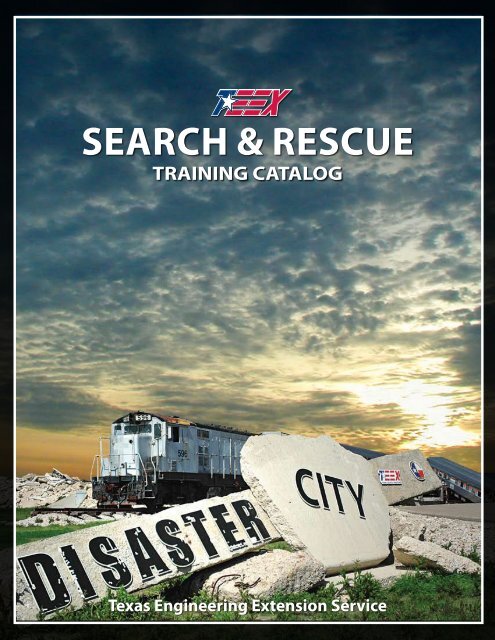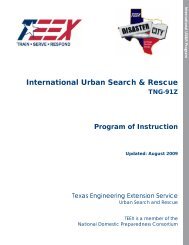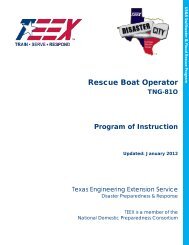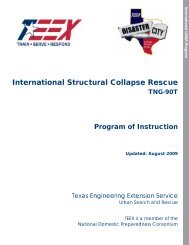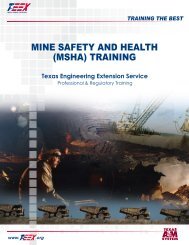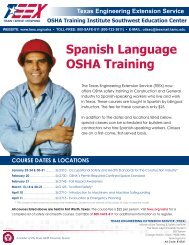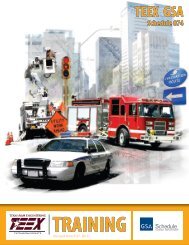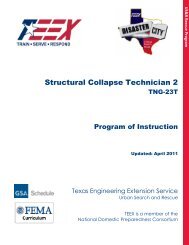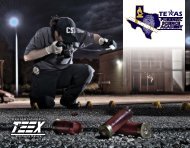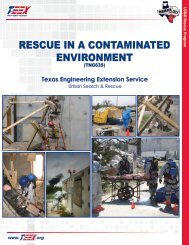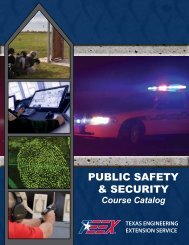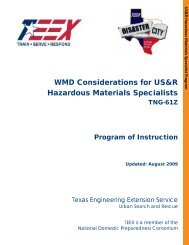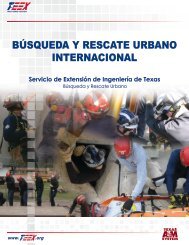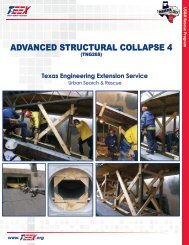SeARCh & ReSCue - TEEX - Texas Engineering Extension Service ...
SeARCh & ReSCue - TEEX - Texas Engineering Extension Service ...
SeARCh & ReSCue - TEEX - Texas Engineering Extension Service ...
You also want an ePaper? Increase the reach of your titles
YUMPU automatically turns print PDFs into web optimized ePapers that Google loves.
Search & Rescue<br />
TRAINING CATALOG<br />
<strong>Texas</strong> <strong>Engineering</strong> <strong>Extension</strong> <strong>Service</strong>
Contents<br />
US&R Rescue Program 4<br />
Structural Collapse – Awareness . . . . . . . . . . . . . . . . . . . . 4<br />
Collapse Rescue Operations . . . . . . . . . . . . . . . . . . . . . . .4<br />
Structural Collapse Technician 2. . . . . . . . . . . . . . . . . . . . .4<br />
Advanced Structural Collapse 3 . . . . . . . . . . . . . . . . . . . . .5<br />
Advanced Structural Collapse 4 . . . . . . . . . . . . . . . . . . . . .5<br />
Medical Considerations for the Rescue Technician . . . . . . . . . . . . 6<br />
Rescue in a Contaminated Environment (RICE) . . . . . . . . . . . . . .6<br />
US&R Search Program 7<br />
Disaster Technical Search Specialist . . . . . . . . . . . . . . . . . . .7<br />
Disaster Canine Search Specialist. . . . . . . . . . . . . . . . . . . . 7<br />
Disaster Canine Workshop . . . . . . . . . . . . . . . . . . . . . . . 7<br />
Wilderness Search and Rescue . . . . . . . . . . . . . . . . . . . . . 8<br />
Wide Area Search . . . . . . . . . . . . . . . . . . . . . . . . . . . 8<br />
US&R Hazardous Materials Specialist Program 9<br />
WMD - Enhanced US&R Operations . . . . . . . . . . . . . . . . . . . 9<br />
WMD Considerations for US&R Hazardous Materials Specialists. . . . . . 9<br />
Swift Water & Flood Rescue Program 10<br />
Swift Water Rescue – Awareness . . . . . . . . . . . . . . . . . . . . 10<br />
Swift Water Rescue – Enhanced Awareness . . . . . . . . . . . . . . . 10<br />
Swift Water Rescue – Operations . . . . . . . . . . . . . . . . . . . . 11<br />
Swift Water Rescue – Operations Upgrade . . . . . . . . . . . . . . . 11<br />
Swift Water Rescue – Technician . . . . . . . . . . . . . . . . . . . . 11<br />
US&R Medical Program 12<br />
Disaster Medical Specialist . . . . . . . . . . . . . . . . . . . . . . . 12<br />
WMD Considerations for the Medical Specialist. . . . . . . . . . . . . 12<br />
US&R Command Staff Program 13<br />
Search and Rescue Task Force Leader . . . . . . . . . . . . . . . . . . 13<br />
Search and Rescue Plans Officer. . . . . . . . . . . . . . . . . . . . 13<br />
Search and Rescue Safety Officer . . . . . . . . . . . . . . . . . . . . 14<br />
Search and Rescue Communications Specialist. . . . . . . . . . . . . 14<br />
Disaster Logistics Specialist . . . . . . . . . . . . . . . . . . . . . . 15<br />
ICS for Structural Collapse Incidents. . . . . . . . . . . . . . . . . . 15<br />
Developing a State/Regional CBRNE Task Force (DHS G&T course: MGT-316).15<br />
International US&R Program 16<br />
International Urban Search and Rescue . . . . . . . . . . . . . . . . . 16<br />
International Structural Collapse Rescue . . . . . . . . . . . . . . . . 16<br />
Full-Scale Exercise Program 17<br />
Full-Scale Exercise Program . . . . . . . . . . . . . . . . . . . . . . 17<br />
Disaster City® and <strong>Texas</strong> Task Force 1 Overview 18<br />
<strong>TEEX</strong> Overview 19<br />
This course can be taught in Disaster City®<br />
This course can be taught at a jurisdiction<br />
within the United States.*<br />
2<br />
This course can be taught overseas.*<br />
*Specific requirements must be met for <strong>TEEX</strong> to deliver a<br />
course outside of Disaster City®
Disaster City®<br />
Preparing search and rescue teams worldwide for the unthinkable is what sets <strong>TEEX</strong> and its renowned Disaster City ® apart from other<br />
training facilities. Located adjacent to the Brayton Fire Training Field in College Station, Disaster City ® is the only facility anywhere<br />
that allows emergency responders to practice search and rescue skills on life-sized, collapsed buildings and damaged infrastructure. The<br />
52-acre urban search and rescue training facility delivers the full array of skills and techniques needed by teams facing threats from manmade<br />
and natural disasters.<br />
3
US&R Rescue Program<br />
www.<br />
.org/USAR<br />
US&R Rescue Program<br />
TNG23A - Structural Collapse – Awareness<br />
4 Hours<br />
The Structural Collapse Awareness course is designed to provide participants<br />
with the knowledge, skills and abilities to understand the complexity of a structural<br />
collapse incident and work safely near and control a structural collapse incident.<br />
Participants will learn the dangers and risks associated with structural collapse incidents.<br />
Participants will understand the basics of scene organization and safety, resources available<br />
to structural collapse rescues, hazards on scene, and conducting visual and verbal<br />
searches.<br />
This course meets NFPA 1670 for jurisdictions that wish to have personnel trained to the<br />
Structural Collapse Awareness level.<br />
Topics<br />
• Recognize the need for a structural collapse search and rescue<br />
• Identify resources necessary to conduct structural collapse rescue<br />
• Initiate the emergency response system for structural collapse incidents<br />
• Initiating site control and scene management<br />
• Hazard recognition including construction types and materials<br />
• Identify the five types of collapse patterns and potential victim locations<br />
• Recognize potential for secondary collapse<br />
• Conduct visual and verbal searches<br />
• FEMA marking systems<br />
• Removing readily accessible victims<br />
TNG23R - Collapse Rescue Operations<br />
50 Hours (5 days)<br />
The Collapse Rescue Operations course is designed to provide students with the knowledge, skills and abilities<br />
to perform rescue at structural collapse scenes due to natural disasters or terrorist incidents.<br />
This course meets and exceeds NFPA 1670 for structural collapse operations. In addition, this course completes<br />
the requirements for structural collapse technician NFPA 1006 when combined with the ICS pre-requisites and<br />
knowledge, skills and abilities in the search of collapse structures, heavy rigging, and pre hospital EMS skills.<br />
Topics<br />
• Rescuer safety<br />
• Structural engineering systems<br />
• Building construction as related to<br />
disaster situations<br />
• Rescue operations strategy and tactics<br />
• Rescue operational procedures<br />
• Rescue support operations<br />
• Breaching and breaking operations (1 day)<br />
• Lifting and moving operations (1 day)<br />
• Emergency building shoring (1 day)<br />
TNG23T - Structural Collapse Technician 2<br />
80 Hours (8 days)<br />
The Structural Collapse Technician 2 course is designed to provide students with the knowledge, skills and abilities<br />
to perform rescue at structural collapse scenes due to natural disasters or terrorist incidents. This course<br />
differs from the Collapse Rescue Operations as it provides increased time to perform more in-depth skill sets as<br />
required by the FEMA US&R curriculum. <strong>TEEX</strong> makes every effort to ensure consistent terminology and training<br />
within the discipline of urban search and rescue, so this course mirrors the FEMA US&R curriculum.<br />
This course meets and exceeds NFPA 1670 and NFPA 1006 for Structural Collapse Technician.<br />
Topics<br />
• Rescuer safety<br />
• Structural engineering systems<br />
• Building construction as related to<br />
disaster situations<br />
• Rescue operations strategy and tactics<br />
• Rescue operational procedures<br />
• Rescue support operations<br />
• Breaching and breaking operations<br />
with concrete and steel structures (2 days)<br />
• Lifting and moving operations (2 days)<br />
• Emergency building shoring (2 days)<br />
4<br />
For prerequisites, gear requirements and complete course information, go to www.<strong>TEEX</strong>.org/USAR
US&R Rescue Program<br />
TNG25S - Advanced Structural Collapse 3<br />
50 Hours (5 days)<br />
The <strong>TEEX</strong> Structural Collapse Technician 2 books and the U.S. Army Corps of Engineers Shoring Operations Guide (SOG) contain significant<br />
additional information and techniques that cannot be covered during a standard 80-hour structural collapse course. The Advanced Structural<br />
Collapse 3 course challenges the Structural Collapse Technician with advanced exterior shoring problems and takes the participant’s skills to the<br />
next level. Students will expand their knowledge of wood shores with multiple insertion point shores, shoring of arches and breached openings.<br />
This course concludes with an intensive and realistic daytime exterior shoring exercise in which the students employ skills learned during the<br />
course. Students are provided with multiple scenarios requiring a combination of advanced rescue and exterior shoring techniques.<br />
Topics<br />
• Rescuer safety<br />
• Exterior shoring size-up and shoring systems<br />
• Building construction as related to<br />
disaster situations<br />
• Exterior raker shores (both single and multiple<br />
insertion points)<br />
• Heavy cribbing<br />
• Confined-space shoring<br />
TNG26S - Advanced Structural Collapse 4<br />
50 Hours (5 days)<br />
The <strong>TEEX</strong> Structural Collapse Technician 2 books and the U.S. Army Corps of Engineers Shoring Operations Guide (SOG) contain significant<br />
additional information and techniques that can not be covered during a standard 80 hour structural collapse course. The Advanced Structural<br />
Collapse 4 course takes the Structural Collapse Technician even further with advanced interior shoring problems. Students will become proficient<br />
in various interior shoring systems, including compound laced post, compound sloped-floor shores, confined space shoring, as well as<br />
tie-backs. The use of crane support in shoring operations will be practiced. This course concludes with an intensive and realistic night-time<br />
exercise in which the student will employ skills learned during the course. The students are provided multiple scenarios requiring a combination<br />
of advanced rescue and interior shoring techniques.<br />
Topics<br />
• Rescuer safety<br />
• Shoring size-up and shoring systems<br />
• Building construction as related to disaster situations<br />
• Raker shores (both single and multiple insertion point)<br />
• Compound laced post<br />
• Compound sloped-floor shores<br />
• Confined-space shoring<br />
• Tie-backs (wire ropes, slings, and rods)<br />
• Crane support in shoring operations<br />
• Window, door, arches, breached opening shoring<br />
<strong>Texas</strong> <strong>Engineering</strong> <strong>Extension</strong> <strong>Service</strong><br />
5
US&R Rescue Program<br />
www.<br />
.org/USAR<br />
TNG24Z - Medical Considerations for the Rescue Technician<br />
16 Hours (2 days)<br />
The Medical Considerations for the Rescue Technician course is designed to provide members of a US&R rescue squad with the knowledge,<br />
skills and abilities to perform some limited medical assessment and treatment of victims during the rescue phase of a structural collapse or<br />
terrorism incident. During the extended extrication of a victim in a structural collapse environment, the rescue squad will be in close contact<br />
with the victim and continually checking their status. This course is not designed to replace the role of the Disaster Medical Specialist (TNG<br />
30S), who is the medically trained member of the US&R team and provides high level medical care to the victim upon extrication. This course<br />
provides training to rescue squad members so they may assist the Disaster Medical Specialist or obtain valuable information from the patient<br />
while awaiting arrival of the Disaster Medical Specialist. This course educates rescue squad members to the unique medical considerations<br />
found in a structural collapse environment, including crush syndrome, airway management issues, and prolonged exposure in the collapsed<br />
structure. This course provides rescue squad members with the understanding of the unique considerations and information vital to pass on to<br />
the Disaster Medical Specialist (TNG 30S) waiting for hands-on access to the patient.<br />
Topics<br />
• Injuries specific to structural collapse environments<br />
• Evaluation of partially accessible patients<br />
• Patient packaging in a structural collapse environment<br />
• Medical cache familiarization<br />
• Case studies: injuries, interventions, and field amputations<br />
TNG63S - Rescue in a Contaminated Environment (RICE)<br />
24 Hours (3 days)<br />
The Rescue in a Contaminated Environment course is designed to provide a Structural Collapse Technician with the opportunity for practical<br />
application of urban search and rescue techniques in a simulated Chemical, Biological, Radiological, Nuclear and Explosive (CBRNE) environment.<br />
The students receive instruction on the hazards and special considerations of performing urban search and rescue operations, including breaching<br />
and breaking, in a contaminated environment. All rescue exercises are conducted in Level B Suits with SCBAs.<br />
Topics<br />
• Rescuer safety in a CBRNE environment<br />
• Chemical, biological, radiological detection<br />
• Building construction as related to disaster situations<br />
• Rescue operations strategy and tactics with CBRNE considerations<br />
• Rescue operational procedures in a CBRNE environment<br />
• Rescue support operations in a CBRNE environment<br />
• Breaching and breaking operations in a CBRNE environment<br />
• Lifting and moving operations in a CBRNE environment<br />
• Emergency building shoring in a CBRNE environment<br />
• Decontamination in a CBRNE environment<br />
6<br />
For prerequisites, gear requirements and complete course information, go to www.<strong>TEEX</strong>.org/USAR
US&R Search Program<br />
TNG11S - Disaster Technical Search Specialist<br />
40 Hours (5 days)<br />
The Disaster Technical Search Specialist course is designed to provide the students<br />
with the knowledge, skills and abilities to perform technical searches of CBRNE and/<br />
or structural collapse incident scenes. A heavy focus is placed on listening devices,<br />
search cameras and GPS-enabled location techniques. This course includes an<br />
intensive and realistic nighttime exercise in which the student will employ skills<br />
learned during the course. <strong>TEEX</strong> makes every effort to ensure consistent terminology<br />
and training within the discipline of urban search and rescue. This course mirrors<br />
the FEMA US&R curriculum but does not provide FEMA certification.<br />
US&R Search Program<br />
Topics<br />
• Structural engineering<br />
• Structural operations<br />
• Navigation & GPS<br />
TNG10S - Disaster Canine Search Specialist<br />
50 Hours (5 days)<br />
The Disaster Canine Specialist course teaches the basic skills necessary for a Disaster Canine Team (handler<br />
and canine) to work safely and reliably in a collapsed structure environment. This course is also appropriate<br />
for the Canine Handler who is “between” dogs, and as such, the course also teaches the handler what to look<br />
for in selecting a new canine partner and what skills the canine needs to be able to perform. For the Search<br />
Manager, the course teaches what to look for when selecting canine teams, what standards the canine team<br />
should be trained to, and the level of support that the teams will need to be successful. <strong>TEEX</strong> makes every<br />
effort to ensure consistent terminology and training within the discipline of urban search and rescue, so this<br />
course mirrors the FEMA US&R curriculum but does not provide FEMA certification.<br />
Topics<br />
• Mission preparedness<br />
• Safety, security and survival<br />
• Canine behavior and drive<br />
• Role of the helper<br />
• Obedience<br />
• Bark alert<br />
• Listening systems<br />
• Visual systems (search cameras)<br />
• Safety and security<br />
• Directability<br />
• Agility<br />
• Rubble search<br />
• Search strategy and tactics<br />
• Canine first aid<br />
• Scent theory<br />
In addition, the <strong>Texas</strong> Task Force 1 Canine Program Manager<br />
will brief participants on:<br />
• Selecting canine(s)<br />
• Developing a canine training program<br />
TNG13Z - Disaster Canine Workshop<br />
8 Hours (1 day)<br />
The Disaster Canine Workshop is a series taught various times throughout the year. The workshop addresses<br />
current training needs within the state of <strong>Texas</strong> and continually improves and/or expands modules to meet<br />
participant expectations. The series is designed to provide students with the knowledge, skills and abilities<br />
necessary to work as a First Responder Canine Handler. This course does not certify the Canine Team, but<br />
instead provides the ability to test the handler and canine in various disaster and/or urban search and rescue<br />
environments. This course can be tailored or expanded to meet the particular needs of your state or regional<br />
team. This workshop should be viewed as quarterly training, and each quarter it is a different set of modules,<br />
covering different topics relating to canine search and rescue.<br />
Topics<br />
• Overview of state disaster response system<br />
• Training the disaster dog in bark and<br />
• Overview of a Task Force mission<br />
reward systems<br />
• Selection process for Task Force canines<br />
• Canine first aid<br />
• Swiftwater awareness and considerations for Canine • SAR clothing<br />
Teams in water search operations<br />
• Survival & improvisation<br />
• Confined space awareness for Canine Teams<br />
• Safety in a search and rescue environment<br />
• HazMat awareness for Canine Teams in search operations • Navigation, map reading and compass<br />
• Training the disaster dog in obedience<br />
operations<br />
• Training the disaster dog in agility<br />
• Passive and active search techniques<br />
• Training the disaster dog in direction and control • Anatomy of a search and rescue incident<br />
<strong>Texas</strong> <strong>Engineering</strong> <strong>Extension</strong> <strong>Service</strong> 7
US&R Search Program<br />
www.<br />
.org/USAR<br />
TNG14O - Wilderness Search and Rescue<br />
16 Hours (2 days)<br />
The Wilderness Search and Rescue course is designed to provide the students with the knowledge, skills and abilities to perform search and<br />
rescue operations in a wilderness environment. A heavy focus is placed on search techniques, navigation and practical skill exercises.<br />
Topics<br />
• Rescue versus recovery<br />
• Clue awareness<br />
• Introduction to canine search operations<br />
• Search theory & sweep width<br />
• Lost person behavior<br />
• Handling evidence<br />
• SAR clothing<br />
• Survival & improvisation<br />
• Safety in a search and rescue environment<br />
• Navigation, map reading and compass operations<br />
• Passive and active search techniques<br />
• Anatomy of a search and rescue incident<br />
OGT500 - Wide Area Search<br />
24 Hours (3 days)<br />
The Wide Area Search course is grant funded by the Department of Homeland Security. The course is provided on-site for eligible jurisdictions<br />
around the United States. This course is applicable to jurisdictions that would need to conduct wide area searches due to a natural disaster or<br />
terrorist incident. Participants will learn the knowledge, skills and abilities to perform wide area searches at a disaster incident site by using the<br />
2007 Greensburg, KS tornado as a case study. The course concludes with a table top exercise that requires participants to utilize the previous<br />
three days of instruction. The curriculum of this course is based on lessons learned from search and rescue deployments to the space shuttle<br />
Columbia recovery, Hurricane Katrina, Hurricane Rita, Hurricane Dolly, and other wide area search incidents.<br />
Topics<br />
• Preparedness<br />
• Information Management and Planning<br />
• Mapping<br />
• Search Strategies and Skills<br />
• Communication<br />
• Team Management<br />
• Field Exercise<br />
8<br />
For prerequisites, gear requirements and complete course information, go to www.<strong>TEEX</strong>.org/USAR
US&R HazMat Specialist Program<br />
TNG61O - WMD – Enhanced US&R Operations<br />
16 Hours (2 days)<br />
The WMD - Enhanced US&R Operations course is designed to provide all members (Fire <strong>Service</strong>, Law Enforcement,<br />
EMS, Public Works, or Military) of a US&R capable task force or team the necessary knowledge, skills<br />
and abilities to support and understand the special considerations when deploying and operating in a CBRNE<br />
environment. It is not feasible for all task force members to be Hazardous Materials Technicians, but this course<br />
provides a basic understanding of the limitations and requirements of a task force when conducting operations<br />
in a CBRNE environment. This course provides training to task force members so they can assist the US&R<br />
Hazardous Materials Specialist during operations and decontamination.<br />
Topics<br />
• Urban search and rescue in a contaminated environment<br />
• The urban search and rescue operational environment<br />
• Urban search and rescue CBRNE personal protective equipment<br />
• Standardized decontamination procedures<br />
• Procedures for administering the Mark I Nerve Agent Antidote Kit<br />
• Chemical agent reference material<br />
US&R Hazardous Materials Specialist Program<br />
TNG60Z - WMD Considerations for US&R<br />
Hazardous Materials Specialists<br />
8 Hours (1 day)<br />
The WMD Considerations for US&R Hazardous Materials Specialists course is designed to provide members of<br />
a US&R Hazardous Materials team with the knowledge, skills and abilities to support operations in a WMD or<br />
hazardous materials environment due to a structural collapse or terrorism incident.<br />
This course is designed to provide additional advanced education to a certified Hazardous Materials Technician<br />
so that they can fill the position of US&R Hazardous Materials Specialist on a US&R Task Force. The US&R Hazardous<br />
Materials Specialist supports the search teams and rescue teams when conducting operations in known or<br />
suspected hazardous environments. The US&R Hazardous Materials Specialist determines appropriate personal<br />
protective equipment and provides team members with monitoring, detection, and sampling. Participants in<br />
this course will review the chemical, physiological properties of possible agents, as well as the characteristics<br />
of biological and radioactive material. Additionally, participants will also review the tactical considerations of<br />
working in a WMD/Hazardous Materials environment and conduct a tabletop exercise.<br />
Topics<br />
• Chemical and physical properties of agents<br />
• Characteristics of biological and radiological material<br />
• Personal protective equipment<br />
• Monitoring, detection, and sampling<br />
• Operation of the ADP200<br />
• Tactical considerations<br />
• Tabletop exercise<br />
<strong>Texas</strong> <strong>Engineering</strong> <strong>Extension</strong> <strong>Service</strong> 9
US&R Swift Water & Flood Rescue Program<br />
www.<br />
.org/USAR<br />
US&R Swift Water & Flood Rescue Program<br />
TNG80A - Swift Water Rescue – Awareness<br />
4 Hours<br />
The Swift Water Rescue course prepares participants to support swift water<br />
rescue operations. Any responder (Fire <strong>Service</strong>, Law Enforcement, EMS, or Public Works)<br />
that is within 10 feet of the water’s edge during a swift water or flood incident should<br />
receive the Swift Water Awareness or Enhanced Awareness course. This course reviews<br />
proper safety at a swift water incident and appropriate personal protective equipment.<br />
Students discuss the importance of scene safety and management, and general hazards.<br />
This course teaches all the knowledge and skills required to perform at the Awareness<br />
level. Awareness level courses are designed for responders who require the skills necessary<br />
to recognize and support a swift water incident. The Awareness level course provides<br />
an overview of specific rescue situations and precautions that responders should<br />
utilize on scene of a swift water incident.<br />
Topics<br />
• Recognize the need for water search and rescue<br />
• Implementing the assessment phase<br />
• Identifying the resources necessary to conduct safe and effective water operations<br />
• Implementing the emergency response system for water incidents<br />
• Implementing site control and scene management<br />
• Recognizing general hazards associated with water incidents<br />
• Determining rescue versus body recovery<br />
• Personal protective and team equipment<br />
• Basic shore-based search techniques<br />
• Assisting with deploying and recovering watercraft<br />
• Shore-based rescue skills<br />
TNG80E - Swift Water Rescue – Enhanced Awareness<br />
8 Hours (1 day)<br />
The Swift Water Rescue – Enhanced Awareness course prepares participants to support swift water<br />
rescue operations. This course provides the same classroom information as the Swift Water Rescue – Awareness<br />
(TNG-80A) course with the addition of two water-based modules: two hours of rope throw bag skills and two<br />
hours of drown proofing of the participants. Any responder (Fire <strong>Service</strong>, Law Enforcement, EMS, Public Works,<br />
or Military) that is within 10 feet of the water’s edge during a swift water or flood incident should receive the<br />
Swift Water Awareness or Enhanced Awareness course. This course reviews proper responder safety at a swift<br />
water incident and appropriate personal protective equipment. Students discuss the importance of personal<br />
safety equipment, swift water dynamics and hydrology, and shore-based rescues. This course teaches all the<br />
knowledge and skills required to perform at the Awareness level. Awareness level courses are designed for<br />
responders who require the skills necessary to recognize and support a swift water incident. The Awareness<br />
level course provides an overview of specific rescue situations and precautions that responders should utilize<br />
on scene of a swift water incident.<br />
Topics<br />
· Recognize the need for water search and rescue<br />
· Implementing the assessment phase<br />
· Identifying the resources necessary to conduct safe and<br />
effective water operations<br />
· Implementing the emergency response system for<br />
water incidents<br />
· Implementing site control and scene management<br />
· Recognizing general hazards associated with water incidents<br />
· Determining rescue versus body recovery<br />
· Personal protective and team equipment<br />
· Basic shore-based search techniques<br />
· Assisting with deploying and recovering watercraft<br />
· Additional hands-on modules:<br />
- Using throw bags<br />
- Drown proofing and basic water survival skills<br />
10<br />
For prerequisites, gear requirements and complete course information, go to www.<strong>TEEX</strong>.org/USAR
TNG80O - Swift Water Rescue – Operations<br />
16 Hours (2 days)<br />
The Swift Water Rescue – Operations course is the first two days of the TNG-80T (Swift Water Rescue – Technician) course. It is two days in length,<br />
eight hours of instruction each day, and prepares participants for defensive rescue situations involving floods and swift-moving water. Students<br />
gain classroom and hands-on experience in preplanning and organization, personal safety equipment, swift-water dynamics and hydrology,<br />
medical considerations in water rescues, self-rescue techniques, and shore-based rescues and the role of watercraft in swift water rescue. This<br />
course teaches all the knowledge and skills required for jurisdictions to perform swift water rescues at the Operations level. This course is a<br />
prerequisite for the TNG-80U (Swift Water Rescue – Operations Upgrade) course. This course is offered on the two days before the Swift Water<br />
Rescue - Operations Upgrade (TNG80U) course. Students have the option upon the successful completion of this course to attend the TNG-80U<br />
(Swift Water Rescue – Operations Upgrade) course the same week, or return to complete it at a later date.<br />
US&R Swift Water & Flood Rescue Program<br />
Topics<br />
· Swift water hydrology<br />
· River dynamics & size-up of flood and swift water rescue<br />
· Developing pre-planning<br />
· Conducting shore-based rescue operations<br />
· Using throw bags<br />
· Shore-based rescue skills<br />
· Assisting technicians with rope and mechanical advantage systems<br />
· Deploying, operating, and recovering watercraft<br />
· Boat-assisted and boat-based operations<br />
· Personal protective and team equipment<br />
· Medical considerations<br />
· Panic, survival, self-rescue, and personal safety<br />
TNG80U - Swift Water Rescue – Operations Upgrade<br />
16 Hours (2 days)<br />
The Swift Water Rescue – Operations Upgrade course is two days in length, eight hours of instruction each day, and prepares participants for<br />
offensive rescue situations involving floods and swift moving water. Students gain classroom and hands-on experience with in-water contact<br />
rescues, to include: tethered swimmer, zip lines, and utilize non-powered boats and the role of watercraft.<br />
This course is only for students that have successfully completed the 16-hour Swift Water Rescue – Operations course (TNG-80O) or<br />
equivalent. The TNG-80U course will bring a Swift Water Rescue - Operations trained person to the Technician level.<br />
Topics<br />
· Deploying, operating, and recovering watercraft<br />
· Boat-assisted and boat-based operations<br />
· Personal protective and team equipment<br />
· Tethered swimmer<br />
· Zip lines<br />
· Tension diagonals<br />
· Medical considerations<br />
TNG80Z -Swift Water Rescue – Technician<br />
32 Hours (4 days)<br />
The Swift Water Rescue - Technician course is four days in length, eight hours of instruction each day, and prepares participants for offensive<br />
rescue situations involving floods and swift moving water. Students gain classroom and hands-on experience in preplanning and organization,<br />
personal safety equipment, swift water dynamics and hydrology, medical considerations in water rescues, self-rescue techniques, shore-based<br />
rescues, in-water contact rescues and the role of watercraft and helicopters in swift water rescue. Any responder (Fire <strong>Service</strong>, Law Enforcement,<br />
EMS, Public Works, and Military) that will be conducting offensive rescues during a swift water or flood incident should receive the Swift Water<br />
Technician course.<br />
This course teaches all the knowledge and skills required to perform swift water rescues at the Technician Level. The first two days of this course<br />
is TNG80O (Swift Water Rescue – Operations) and the second two days of this course is TNG80U (Swift Water Rescue – Operations Upgrade).<br />
Topics<br />
· Swift water hydrology<br />
· River dynamics & size-up of flood and swift water rescue<br />
· Developing pre-planning<br />
· Conducting shore-based rescue operations<br />
· Using rope throw bags<br />
· Constructing and utilizing rope and mechanical advantage systems<br />
· Deploying, operating, and recovering watercraft<br />
· Boat-assisted and boat-based operations<br />
· Personal protective and team equipment<br />
· Medical considerations<br />
· Panic, survival, self-rescue, and personal safety<br />
· Shore-based rescue skills<br />
· Conducting in-water rescues during the day and night<br />
· In-water rescues by helicopter<br />
<strong>Texas</strong> <strong>Engineering</strong> <strong>Extension</strong> <strong>Service</strong> 11
US&R Medical Program<br />
www.<br />
.org/USAR<br />
US&R Medical Specialist Program<br />
TNG30S - Disaster Medical Specialist<br />
50 Hours (5 days)<br />
The Disaster Medical Specialist course is designed to<br />
provide the students with the knowledge, skills and abilities<br />
to perform medical assessment and care at a structural<br />
collapse disaster scene due to natural disasters or terrorist incidents. This course exposes<br />
the student to the injury types consistent with structural collapse incidents. A heavy<br />
focus is placed on providing medical care in a confined space. This course is 50 percent<br />
classroom and 50 percent field-based exercises. This course also provides a half day on<br />
search canine veterinary care because medical specialists would be the first to treat<br />
injured search canines on scene. A prerequisite of this course is that the participant is a<br />
registered EMT-P (paramedic), registered nurse, or licensed doctor.<br />
<strong>TEEX</strong> makes every effort to ensure consistent terminology and training within the discipline<br />
of urban search and rescue, so this course mirrors the FEMA US&R curriculum but<br />
does not provide FEMA certification.<br />
Topics<br />
• Public health and environmental issues<br />
• Sudden onset calamities<br />
• Victim medical problems<br />
• Crush syndrome<br />
• Improvised explosive device and blast injuries<br />
• Confined space medical and tactical care considerations and operations<br />
• Austere care<br />
• Mainstays of patient care<br />
• Search canine veterinary care<br />
TNG31Z - WMD Considerations for Medical Specialists<br />
8 Hours (1 day)<br />
The WMD Considerations for Medical Specialists course is designed to provide members of a US&R<br />
Medical Team with the knowledge, skills and abilities to provide medical support to a task force operating in a<br />
WMD or hazardous materials environment due to a structural collapse or terrorism incident.<br />
This course is designed to provide additional advanced education to a Disaster Medical Specialist. This course<br />
is appropriate for members of a US&R Medical Team that will be required to medically support the search teams<br />
and rescue teams which are conducting operations in known or suspected hazardous environments. This course<br />
builds upon the Disaster Medical Specialist course and provides additional specific information on procedures to<br />
prevent secondary contamination of emergency medical personnel at a WMD Incident. Participants will understand<br />
the issues associated with body substance isolation, and decontamination of medical specialists responding<br />
to a WMD incident. Participants will be given a potential target hazard scenario for a WMD incident and then<br />
required to develop a medical safety plan that addresses appropriate PPE and monitoring considerations for use<br />
by the US&R Medical Team. Participants will understand the importance of detection and monitoring in a WMD<br />
environment. Participants will discuss on-scene medical care for casualties of a WMD incident. Additionally, participants<br />
will be given a multicasualty scenario involving WMD materials and be required to construct a patient<br />
treatment plan.<br />
Topics<br />
• Self-protection for medical providers<br />
• Issues associated with secondary contamination & body<br />
substance isolation<br />
• Decontamination for US&R Medical Team members<br />
• Medical responder protection<br />
• Importance of detection and monitoring<br />
• Personal protective equipment<br />
• Developing a medical safety plan<br />
• On-scene medical care<br />
• Constructing a patient treatment plan<br />
12<br />
For prerequisites, gear requirements and complete course information, go to www.<strong>TEEX</strong>.org/USAR
US&R Command Staff Program<br />
TNG55Z - Task Force Leader<br />
40 Hours (5 days)<br />
The Task Force Leader course is designed to provide the participants with the knowledge,<br />
skills and abilities to understand the responsibilities of a Task Force Leader for a<br />
CBRNE-capable Type 1 Urban Search and Rescue Task Force. This course is also appropriate<br />
for those that would be a Task Force Leader for a Type 2 or 3 US&R task force and/<br />
or strike team. This course addresses the administrative and operational requirements<br />
that a Task Force Leader is faced with during an incident response. The Task Force Leader<br />
will learn the tasks of coordinating and supervising the readiness and deployment<br />
of a team of specialists and managers within the six major functional areas of a task<br />
force: command, logistics, planning, search, medical, and rescue. Participants learn the<br />
interdependence of the six major functional areas and how to effectively manage those<br />
interactions.<br />
US&R Command Staff Program<br />
Topics<br />
• Task Force Leader roles and responsibilities<br />
• FEMA Incident Support Team (IST) overview<br />
• Task force program management<br />
• Legal and liability issues<br />
• Logistics<br />
• Task force management<br />
• Task force tactical operations<br />
- Chronology and sequencing<br />
- Decision making process<br />
- Coordination<br />
- WMD and CBRNE considerations<br />
- Reconnaissance & search<br />
- Rescue & medical operations<br />
• Demobilization and post mission requirements<br />
TNG 53Z - Search and Rescue Plans Officer<br />
40 Hours (5 days)<br />
The Search and Rescue Plans Officer course is designed to provide the participants with the knowledge, skills and<br />
abilities to perform as a member of the Plans Team or as a Technical Information Specialists on a Type 1 deployed<br />
CBRNE capable US&R task force. This course trains responders to work as a part of a Plans Team before, during<br />
and after an urban search and rescue incident. Each jurisdiction should send two participants to the course;<br />
one plans officer and one technical information specialist. The two participants will work together during the<br />
tabletop exercises just as they would during an actual incident. A heavy focus is placed on 24-hour operations,<br />
long term planning and use of the ICS forms and documentation. This class is also appropriate for responders<br />
who would serve as the Plans Officer or Technical Information Specialist for a Swift Water Task Force or Swift Water<br />
Strike Team.<br />
This course was initially designed by FEMA for those working as a Plans Officer or Technical Information Specialist<br />
for a Type 1 FEMA National US&R Task Force.<br />
<strong>TEEX</strong> makes every effort to ensure consistent terminology and training within the discipline of urban search and<br />
rescue, so this course mirrors the FEMA US&R curriculum but does not provide FEMA certification.<br />
Topics<br />
• Overview of the US&R planning process<br />
• Pre-incident planning activities<br />
• Task force advisory, alert and activation<br />
• Initial on-site operations<br />
• Mapping & displays<br />
• GPS /computer interface and integration<br />
• Incident photography and worksite<br />
documentation<br />
• Situation reporting<br />
• Demobilization planning<br />
• After-action reporting & image preservation<br />
<strong>Texas</strong> <strong>Engineering</strong> <strong>Extension</strong> <strong>Service</strong><br />
13
US&R Command Staff Program<br />
www.<br />
.org/USAR<br />
TNG54Z - Search and Rescue Safety Officer<br />
32 Hours (4 days)<br />
The Search and Rescue Safety Officer course is designed to provide the participants with the knowledge, skills and abilities to oversee first<br />
responder safety during a Task Force or Strike Team incident response. Participants will learn how to apply Occupational Safety and Health<br />
Administration (OSHA) regulations and National Fire Protection Association (NFPA) standards to search and rescue operations. Additionally, the<br />
participants will be able to identify different types of damaged structures, the hazards most common to damaged structures, and the methods<br />
that have been used to mitigate those hazards.<br />
Topics<br />
• Safety rules, regulations and standards applicable at the Search and rescue incident<br />
• Identifying hazards at the search and rescue incident<br />
• Monitoring and mitigation at the search and rescue incident<br />
• Accident investigation at the search and rescue incident<br />
• NIMS and the incident command system<br />
• Risk management at the search and rescue incident<br />
• Structural collapse risk analysis<br />
The course contains multiple exercises applying all knowledge, skills, and<br />
abilities gained during duration of the course.<br />
TNG70S - Search and Rescue Communications Specialist<br />
46 Hours (5 days)<br />
The Search and Rescue Communications Specialist course is 46 hours, five days in length, approximately nine hours of instruction each day,<br />
and is designed to provide the participants with the knowledge, skills and abilities to establish, manage, and troubleshoot all levels of communications<br />
for a Task Force or Strike Team incident response. Participants will learn how establish and utilize radio and satellite communication<br />
systems in austere environments during US&R operations.<br />
<strong>TEEX</strong> makes every effort to ensure consistent terminology and training within the discipline of urban search and rescue, so this course mirrors<br />
the FEMA US&R curriculum but does not provide FEMA certification.<br />
Topics<br />
• Communication specialist roles and responsibilities<br />
• Communication procedures and practices<br />
• Information & communication security<br />
• Health and safety considerations<br />
• US&R response system<br />
• Incident support requirements<br />
• Communication cache & accountability<br />
• NIMS & ICS forms and procedures<br />
• Developing a communications plan<br />
• Frequency issues and interoperability<br />
• Operational considerations, coverage zones, and troubleshooting<br />
• Task force communications training<br />
• Communication-based practical field exercise<br />
14 For prerequisites, gear requirements and complete course information, go to www.<strong>TEEX</strong>.org/USAR
TNG40S - Disaster Logistics Specialist<br />
40 Hours (5 days)<br />
The Disaster Logistics Specialist course is designed to provide participants with the foundational knowledge, skills and abilities to perform<br />
logistics function during a disaster or a planned event. Keeping an all-risk environment in mind, this course exposes the student to essential<br />
requirements of providing support, re-supply, transportation, sustenance and maintenance of a disaster or planned event equipment and the<br />
personnel. <strong>TEEX</strong> makes every effort to ensure consistent terminology and training within the discipline of the Incident Command System and the<br />
National Incident Management System. Therefore it explores all six of the logistics section unit functions and their respective interactions and<br />
responsibilities.<br />
Topics<br />
• Facilities Unit<br />
• Supply Unit<br />
• Ground Support Unit<br />
• Food Unit<br />
• Medical Unit<br />
• Hazardous Materials Transportation Awareness<br />
• Communications Unit<br />
US&R Command Staff Program<br />
TNG58Z - ICS for Structural Collapse Incidents<br />
16 Hours (2 days)<br />
The ICS for Structural Collapse Incidents course is designed to provide members of a US&R command staff with the knowledge, skills and abilities<br />
to perform leadership at structural collapse scenes due to natural disasters or terrorist incidents. This course is specifically designed for participants<br />
who already have an understanding of the Incident Command System and builds upon the ICS 100 and 200 level training. This course is<br />
designed to provide fire officers and Task Force Leaders with the understanding of command operations at structural collapse incidents.<br />
Topics<br />
• Describing the aspects of a structural collapse<br />
• Explaining basic command procedures and ICS organizational structure<br />
• Identifying various resource levels, types, and capabilities used for<br />
structural collapse incidents<br />
• Identifying critical factors and issues that affect scene management<br />
• Describing all unique operational considerations used at a structural collapse incident<br />
• Describing all response operations phases associated with a structural collapse incident<br />
• Describing the technical rescue expertise and equipment required for safe operations and<br />
effective incident management<br />
MGT316 - Developing a State/Regional CBRNE Task Force<br />
24 Hours (3 days)<br />
The Developing a State/Regional CBRNE task force course is designed to provide the sponsoring jurisdiction with the knowledge to develop,<br />
train, sustain and deploy a task force capable of conducting offensive operations at incidents involving chemicals, biological agents, radiation,<br />
nuclear material or explosives. This course includes instructor-led discussions, small group writing assignments and presentations. All course<br />
students will actively work together during the course to write a concept plan for their regional task force.<br />
Topics<br />
• Function of a CBRNE task force<br />
• Task force concept plan<br />
• Task force training and equipment<br />
• Task force personnel selection<br />
• Activation and deployment<br />
<strong>Texas</strong> <strong>Engineering</strong> <strong>Extension</strong> <strong>Service</strong><br />
15
International US&R Program<br />
www.<br />
.org/USAR<br />
International US&R Program<br />
TNG91Z - International Urban Search and Rescue<br />
100 Hours (10 days of instruction)<br />
The International Urban Search and Rescue course is designed to provide students with<br />
the knowledge, skills and abilities to perform rescue at structural collapse scenes due to<br />
natural disasters or terrorist incidents. This course is specifically designed for students<br />
located outside the United States and provides a number of learning modules at the beginning<br />
of the course which will provide necessary prerequisite knowledge. This course<br />
exposes students to the most advanced knowledge available for structural collapse incidents.<br />
Additionally, students have the option to tailor certain modules to meet the urban<br />
conditions specific to their home country.<br />
Topics<br />
• Rescuer safety<br />
• Structural engineering systems<br />
• Building construction as related to disaster situations<br />
• Rescue operations strategy and tactics<br />
• Rescue operational procedures<br />
• Rescue support operations<br />
• Breaching and breaking operations with concrete and steel structures<br />
• Lifting and moving operations<br />
• Emergency building shoring<br />
Additional Modules<br />
• Search management<br />
• Search operations and mapping<br />
• Patient packaging<br />
• Canine search<br />
• GPS<br />
TNG90T - International Structural Collapse Rescue<br />
80 Hours (8-10 days, depending on schedule)<br />
This course is typically 80 hours, eight days in length, 10 hours of instruction each day. The length and content<br />
of the course can be adjusted to meet the requirements of the jurisdiction. The International Structural Collapse<br />
Rescue course is offered on location and utilizes equipment supplied by the customer. The course is designed<br />
to provide the participants with the knowledge, skills and abilities to perform rescue at structural collapse scene<br />
due to natural disasters or terrorist incidents. This course is the same as TNG91Z but excludes the 20 hours of<br />
additional modules. This course is specifically designed for jurisdictions located outside the United States and<br />
provides jurisdictions the opportunity to train in their area, utilize their own equipment, and test their local<br />
response procedures. <strong>TEEX</strong> will work with the jurisdiction on the type and quantity of rescue equipment that will<br />
be utilized during this course. This course is delivered outside the United States at a local jurisdiction and utilizes<br />
the equipment available to the host jurisdiction.<br />
This course is custom built to the needs of the host jurisdiction. The core course objectives mirror the Structural<br />
Collapse Technician 2 (TNG 23T) course and changes can be made based on specific training requirements. The<br />
US&R Training Program can increase or decrease the amount of instruction and hands-on tool time for the following<br />
skills sets:<br />
• Breaching and breaking operations<br />
• Shoring construction<br />
• Lifting and moving operations<br />
This course exposes students to the most advanced knowledge available<br />
for structural collapse incidents.<br />
Topics<br />
• Rescuer safety<br />
• Structural engineering systems<br />
• Building construction as related to disaster situations<br />
• Rescue operations strategy and tactics<br />
• Rescue operational procedures<br />
• Rescue support operations<br />
• Breaching and breaking operations with concrete and steel structures<br />
• Lifting and moving operations<br />
• Emergency building shoring<br />
16<br />
For prerequisites, gear requirements and complete course information, go to www.<strong>TEEX</strong>.org/USAR
US&R Full-Scale Exercise Program<br />
Full-Scale Exercise Program<br />
The Full-Scale Exercise Program (FSE) is designed for military units and jurisdictions that require training and<br />
scenario-based exercises for terrorist incidents or natural disasters. FSEs are conducted in Disaster City®, located<br />
in College Station, <strong>Texas</strong>. Disaster City® is a 52-acre urban search and rescue training facility that delivers the<br />
full array of skills and techniques needed by today’s civil support teams, US&R teams and emergency responders.<br />
Training is led by instructors who have responded to some of the largest disasters on record, including the<br />
9/11 World Trade Center attacks, the space shuttle Columbia incident and Hurricane Katrina. <strong>TEEX</strong> conducts<br />
yearly FSEs and has assisted in conducting full-scale exercises in Disaster City® for the following teams:<br />
US&R Full-Scale Exercise Program<br />
• <strong>Texas</strong> Task Force 1<br />
• 6th WMD-CST (<strong>Texas</strong>)<br />
• San Francisco Fire Department with the 95th WMD-CST (California)<br />
• 63rd WMD-CST (Oklahoma)<br />
• TX-DMAT 4<br />
<strong>TEEX</strong> and Disaster City® can provide full-scale exercise scenarios to test and evaluate your team based on your<br />
required goals. Each exercise prepares your team to respond and understand the various challenges at CBRNE/<br />
WMD incidents, a structural collapse or a natural disaster. Scenarios are designed using objectives provided by<br />
your command and training staff. FSEs are designed around current revisions to the National Response Plan,<br />
the National Incident Management System (NIMS), and follow all Incident Command System (ICS) principles.<br />
Sample exercise scenarios:<br />
• Dirty bomb attack on a government building<br />
• Chemical attack on a passenger train<br />
• Improvised explosive device (truck, car, suitcase, suicide bomber)<br />
• Aerosol anthrax attack on theater or shopping mall<br />
• Radiological dispersal device<br />
• Blister or nerve agent attack<br />
• Train car derailment/explosion - chemical tanker<br />
• Highway truck accident/explosion - chemical tank trailer<br />
• Collapsed structure and rubble pile survey and sampling<br />
• Earthquake<br />
• Hurricane<br />
• Tornado<br />
Responding teams will be assigned a base of operations near Disaster City® and will have to quickly integrate<br />
themselves into the incident command system. Briefings, operational objectives and status reports will happen<br />
in real time, just like an actual incident. Various levels of city and government officials (role players) from<br />
the affected jurisdiction will interact with your team and commanders. This unique level of detail and realism<br />
provides the opportunity for the team to interact and work with actual emergency responders during exercises.<br />
Exercise Role Players and Observer/Controllers:<br />
<strong>TEEX</strong> can provide a staff of professional role players, actors, and victims that add a high level of realism to the<br />
exercise scenarios. Teams responding to Disaster City® will interface with role players who have professional<br />
backgrounds as fire or police responders, US&R task force personnel, federal agents, public works officials and<br />
emergency managers. All Observer/Controllers (O/Cs) in Disaster City® are responders with real-world experience<br />
at some of the largest modern day disasters. The O/C team may be comprised solely of <strong>TEEX</strong> staff or could<br />
include personnel of your choosing for an unparalleled training experience.<br />
<strong>Texas</strong> <strong>Engineering</strong> <strong>Extension</strong> <strong>Service</strong> 17
Disaster City® and <strong>Texas</strong> Task Force 1<br />
“We looked at several training<br />
facilities worldwide specializing<br />
in search and rescue, but none<br />
compared to what we found<br />
at Disaster City ® .<br />
– dave dickson<br />
usar advisor<br />
u.k. civil resilience directorate<br />
office of the deputy prime minister<br />
“<br />
18<br />
Emergency responders from throughout the United States and<br />
around the globe count on <strong>TEEX</strong> for unrivaled search and rescue<br />
training and exercises at a venue like no other – Disaster City ® .<br />
Located in College Station, the facility is designed to provide the<br />
full array of skills and techniques needed by emergency response<br />
professionals.<br />
Disaster City ® features full-size, collapsible structures that replicate<br />
community infrastructure, including a strip mall, office<br />
building, industrial complex, assembly hall/theater, single-family<br />
dwelling and train derailment, government complex, as well as<br />
three rubble piles. Responders enhance their search and rescue<br />
skills at work stations that recreate real-life disaster scenarios<br />
using state-of-the-art search and rescue tools. Disaster City ® is the<br />
home training facility for <strong>Texas</strong> Task Force 1 and also hosts numerous<br />
operational readiness exercises for military, federal, state and<br />
local search and rescue teams. The facility’s vast and diverse infrastructure<br />
provides the capability to sustain training and exercises<br />
over multiple operational periods.<br />
Additionally, the 52-acre Disaster City ® is one of the nation’s top<br />
training and evaluation sites for search and rescue canines and<br />
their handlers, having hosted the Federal Emergency Management<br />
Agency’s (FEMA) prestigious Disaster Search Canine Readiness<br />
Evaluation twice over the past two years. The facility has<br />
also hosted the National Institute of Standards and Technology’s<br />
(NIST) Response Robot Evaluation Exercise. <strong>TEEX</strong> serves as the<br />
sponsoring agency for <strong>Texas</strong> Task Force 1, one of FEMA’s 28 federal<br />
urban search and rescue teams and the only Type 1 statewide<br />
urban search and rescue team in <strong>Texas</strong>. The Task Force, which is<br />
under direction of the Governor’s Division of Emergency Management,<br />
is also responsible for the state’s water rescue program.<br />
With more than 400 members from 60 different organizations,<br />
<strong>Texas</strong> Task Force 1 has responded to major disasters such as 9/11,<br />
the space shuttle Columbia explosion, the <strong>Texas</strong> A&M Bonfire collapse<br />
and Hurricanes Ivan, Katrina and Rita.<br />
<strong>TEEX</strong> has played a key role in the development of urban search<br />
and rescue teams at the local and state levels in the United States<br />
and throughout the United Kingdom. <strong>TEEX</strong>-trained urban search<br />
and rescue personnel from the London Fire Brigade responded to<br />
the July 7, 2005, terrorist attacks and credited their preparedness<br />
to their training at Disaster City ® .<br />
<strong>TEEX</strong> also assisted in establishing the United States’ prepositioned<br />
equipment capability, as well as a national program<br />
to test the effectiveness and validity of homeland security<br />
equipment across several emergency response disciplines.
<strong>Texas</strong> <strong>Engineering</strong> <strong>Extension</strong> <strong>Service</strong><br />
The <strong>Texas</strong> <strong>Engineering</strong> <strong>Extension</strong> <strong>Service</strong><br />
develops a skilled and trained workforce<br />
f i r e s e r v i c e s<br />
Em e r g e n c y Se r v i c e s Training In s t i t u t e<br />
Tel: 866-878-8900 (toll-free)<br />
E-mail: esti@teexmail.tamu.edu<br />
that enhances the public safety, security and<br />
economic growth of the state and the nation<br />
through training, technical assistance and<br />
s e a r c h & r e s c u e<br />
Tel: 888-999-9775 (toll-free)<br />
E-mail: usar@teexmail.tamu.edu<br />
emergency response.<br />
The <strong>Texas</strong> <strong>Engineering</strong> <strong>Extension</strong> <strong>Service</strong> (<strong>TEEX</strong>) is an internationally<br />
recognized leader in the delivery of emergency response and<br />
workforce training, exercises and technical assistance. A member<br />
of The <strong>Texas</strong> A&M University System, the agency provides handson,<br />
customized training solutions that impact the homeland<br />
security and the occupational and economic development of<br />
<strong>Texas</strong> and beyond.<br />
<strong>TEEX</strong> serves more than 220,000 people representing all 50 states,<br />
the District of Columbia, five U.S. territories and 57 countries each<br />
year through training and technical assistance. Major <strong>TEEX</strong> programs<br />
include fire services, search and rescue, homeland security,<br />
public safety and security, public works, safety and health, and<br />
economic development.<br />
The agency’s ongoing efforts for the past 80 years have resulted<br />
in cleaner drinking water, better roads and infrastructure,<br />
improved workplace safety, enhanced homeland security and<br />
increased public safety. <strong>TEEX</strong> enhances the technical skills of employed<br />
workers and those entering the workforce while helping<br />
manufacturers adopt new technologies to improve productivity<br />
and profits.<br />
Private sector customers and public agencies count on <strong>TEEX</strong> for<br />
the excellent training and technical expertise provided by more<br />
than 1,000 employees and adjunct instructors, many of whom are<br />
the top experts in their fields. <strong>TEEX</strong> provides its unique, specialized<br />
training, exercises and technical assistance worldwide for<br />
customers ranging from small volunteer fire departments to large<br />
international companies.<br />
Home to the National Emergency Response and Rescue Training<br />
Center, <strong>TEEX</strong> has been at the forefront of preparing emergency<br />
responders to combat natural disasters and terrorist incidents<br />
involving weapons of mass destruction since 1998. In addition,<br />
<strong>TEEX</strong> is the sponsoring agency for <strong>Texas</strong> Task Force 1, which<br />
serves as a state and federal urban search and rescue team and is<br />
responsible for <strong>Texas</strong>’ swift water rescue program.<br />
h o m e l a n d s e c u r i t y<br />
Na t i o n a l Em e r g e n c y Res p o n s e & Res c u e Training Ce n t e r<br />
Tel: 877-438-8877 (toll-free)<br />
E-mail: nerrtc@teexmail.tamu.edu<br />
p u b l i c s a f e t y & s e c u r i t y<br />
Tel: 800-423-8433 (toll-free)<br />
E-mail: publicsafety@teexmail.tamu.edu<br />
p u b l i c w o r k s<br />
En g i n e e r i n g, Ut i l i t i e s & Pu b l i c Wo r k s Training In s t i t u t e<br />
Tel: 800-824-7303 (toll-free)<br />
E-mail: eupwti@teexmail.tamu.edu<br />
s a f e t y & h e a lt h<br />
Pr o f e s s i o n a l & Re g u l a t o r y Training<br />
Tel: 800-723-3811 (toll-free)<br />
E-mail: otisec@teexmail.tamu.edu<br />
e c o n o m i c d e v e l o p m e n t<br />
Te c h n o l o g y & Ec o n o m i c De v e lo p m e n t<br />
Tel: 800-541-7149 (toll-free)<br />
E-mail: ted@teexmail.tamu.edu<br />
o f f i c e o f g r a n t s & t r a i n i n g<br />
Tel: 877-438-8877 (toll-free)<br />
E-mail: ogt@teexmail.tamu.edu<br />
19
Urban Search & Rescue<br />
301 Tarrow<br />
College Station, TX 77840-7896<br />
Toll-free 888-999-9775<br />
usar@teexmail.tamu.edu<br />
www.teex.org/usar<br />
C08.2973.11


